(Note: this post will be of interest only to camera geeks)
My previous post contained a superficial listing of considerations for building a tripod, and left off wondering how to test the effect of various ways to use a tripod. For example, how detrimental is it to add a center column? How beneficial is mirror lock up? Since getting my really nice tripod, I find myself wanting to learn how to use it properly, and these questions are a big part of that.
I tend to dive into things looking for answers, as evidenced by the posts in my photography-tech category, such as my auto-focus test chart, my analysis of NEF compression, my seven-page writeup on digital-image color spaces, or my Lightroom metadata-panel presets builder. In this case, I'm not really sure how to proceed, but I've come up with some tests and results that at least form a basis for further study.
I'm not really sure how relevant the test I'm about to present are, both in theory and in how I executed them. One of the reasons for my writing this post is to solicit comments on the validity of my methodology and interpretation.
The Tests
I created a simple test-pattern image, shown here at quarter size (click to see the full-sized version):
I set up my tripod at one end of the longest hallway in my home, and displayed the test pattern on my laptop's screen at the other end 16m (53 feet) away. I mounted the big Nikkor 70-200 f/2.8 onto my D200. My goal was to get something that had bulk to challenge the tripod support system, and also reach (high magnification) to exaggerate the effects of any instability. (Frankly, a 200mm lens is not really very much magnification, but it's the best that I have at hand.)
To give you an idea of what I am testing with, here's a picture from my tripod post showing the camera and lens mounted on my ballhead.
I took dozens and dozens of one-second test exposures under various conditions. (See this post for a discussion of why a one-second shutter speed was chosen, and for other technical details about how the tests were performed.)
For reference, here's what one of them looked like, with my laptop showing the test screen in the center:

Cropping out all but the center part of interest, the result might look like this:
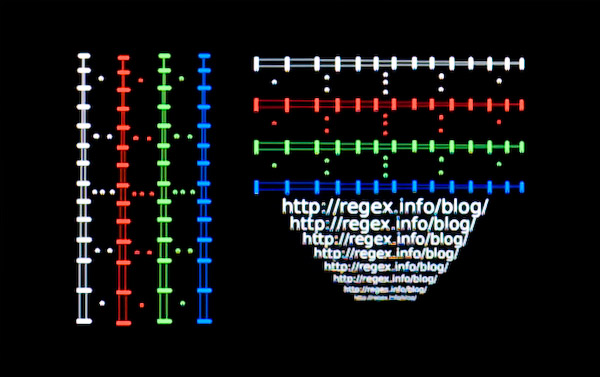
Nikon D200 + Nikkor 70-200mm f/2.8 @ 200mm — 1 sec, f/8, ISO 100 — full exif
Test Pattern, from 53 Feet Away
I took long one-second exposures to highlight the ill effects of vibration and instability. The example crop above might not look very sharp, but considering that it's a one-second exposure and that it's a 1/44th-crop from the full frame, I think it's pretty good.
It seems especially good when you compare it to using a bad tripod, or handheld without a tripod. Mouse over the buttons below this next image, to compare among a few different results...

mouseover a button to see that image
I'll talk about these and other results in more detail in another post, but these are some of the most broad results for which the conclusions were already fairly predictable: a good tripod is better than a bad one, and a bad one is better than no tripod.
For reference, here is a bit about the images being compared...
All but the last are one-second exposures at f/8 and ISO 100. It's crazy to try to hand-hold a 200mm shot for one second. (Heck, I was lucky to get a 17mm shot crisp at 1/8th of a second in this post).
So, the final “handheld (sane?)” shot uses all the technology my camera has to offer to better my odds at a less-shaky result. I opened the aperture three stops (from f/8 to f/2.8) and bumped up the ISO five stops (from 100 to 3,200), which allowed me to increase the shutter speed by eight stops (from 1 second to 1/250th of a second). Even then, the shake is still much worse than the “good tripod” result, not to mention the lower quality due to the high ISO and less-sharp aperture.
The “good tripod” represents bad technique with a reasonably good tripod: I used my Gitzo tripod with its center column down and only three of the four leg sections extended. That's all fine, but the bad technique is that I pressed the shutter button by hand rather than using a remote shutter release.
The “bad tripod” version used the same bad technique, but with a flimsy tripod totally inappropriate for the big camera and lens (a Velbon ULTRA MAXi F, described here).
Finally, the “Most Solid” version used my big Gitzo legs without any leg extension, no center column, and no ballhead (using the Really Right Stuff B2-Pro quick-release clamp from my monopod bolted directly to the legs). This is a fairly impractical setup, but extremely solid and stable, so I use it as a reference. I also used mirror-up mode, waiting at least 10 seconds after putting the mirror up before activating the shutter.
In a future post, I'll use some of the other 66 test images to isolates the effects of using mirror lockup, a remote shutter release, all four leg sections (compared to three leg sections), a center column, and more.
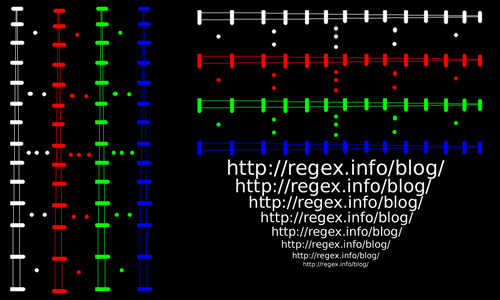
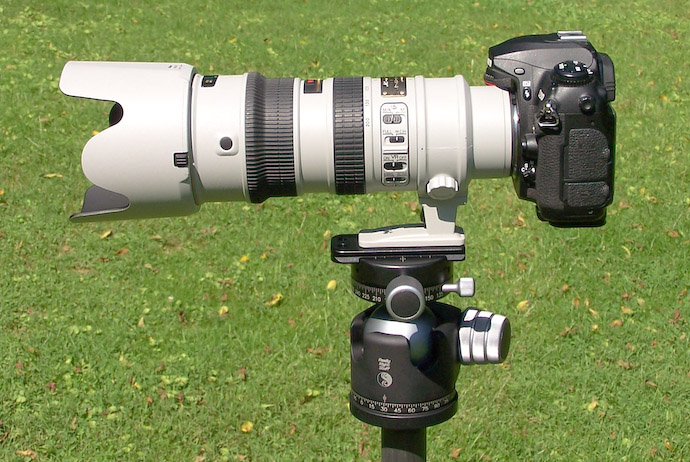

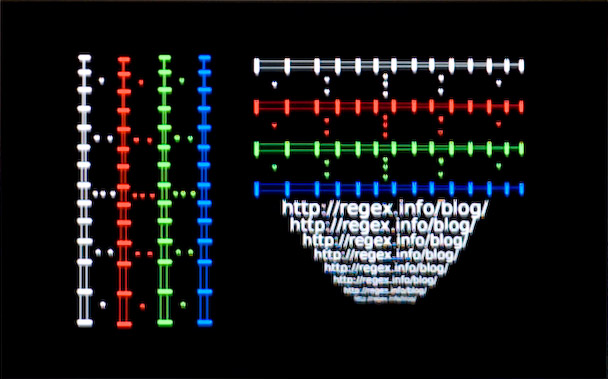
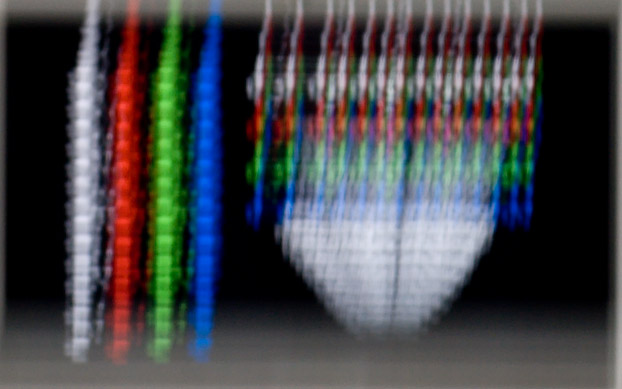
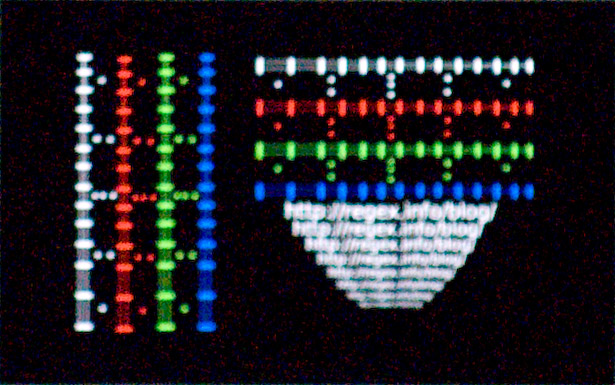
I like your analytical approach! Looking forward to Part II.
Also, perhaps, some equivalent tests of your new monopod would be interesting. I’ve seen people making subjective claims of gaining 2-3 stops using a monopod, versus hand-held, but it’d be nice to see them substantiated – or not.
Peter
A one second exposure may not be optimal for testing a tripod. If there are some transient vibrations from mirror slap or from hitting the button, they could dissipate during the first part of that exposure. It might be interesting to try a range of exposures to find those that are most sensitive — not too fast to freeze action but also not too slow to allow the camera to settle.
During the 1-second exposure, while the camera is settling, the shutter is open, so any movement during the whole time results in a blurred picture. It’s sort of a worst-case test, since much better results can be gotten with a more realistically fast exposure. But then again, it’s not uncommon to have really long exposures in certain classes of photography (like these), so the 1-second test exposures are still only a beginning…. —Jeffrey
Nice test, one dreawback: The last handheld shot isn’t (much?) motion blurred, it’s simply Out of focus 😉
That’s certainly a possibility, but unlikely because I used the split-prism of my Katz-Eye focus screen to make sure that I had the focus nailed each time. Using ISO 3,200 on a D200 really kills the detail due to noise, and 200mm at only 1/250th of a second leaves ample room for blur, especially when pixel peeping like we’re doing here.
I do notice, though, that all the images tend to lose focus when I look at them after having a beer. I must research this aspect of tripods much more thoroughly. 🙂 —Jeffrey
Re: 1 second exposure.
I think I wasn’t clear. Push this out the limit and lets talk about a 30 second exposure. Lets also say that it takes 0.3 seconds for any vibrations from opening the shutter, mirror slap, hitting button, etc. to settle. The percentage of the exposure that is subject to vibration is very small in this case — just 1% of the exposure time. This means that any blurring during that transient vibration will be very dim. However, if the shutter time is 0.3 seconds, then 100% of the exposure will be subject to the vibration. This means that (ignore noise) a 1 second exposure would look better than a 0.3 second exposure.
Now — this is just any transient vibrations due to actually starting the exposure and are probably due more to technique than the actual stability of the support system. Any ambient vibration (earthquakes, stepping around the tripod on soft ground, house moving, trains going by) won’t be subject to the same issues, of course.
(I wish I had a whiteboard to help describe what I’m saying 😉
I think I understood you (you were clear enough), but I still think that it doesn’t matter whether the exposure is lengthened after some vibration-induced blur has been recorded, the blur is still there and isn’t diminished by the shutter remaining open. Perhaps you’re thinking that I picked an exposure that would be correct based on a 1-second shutter, and in doing so something that lasts only a fraction of that won’t create enough light to register well on the sensor, but that’s not what’s happening here.
Think more along the lines of a long exposure for fireworks: the length of the exposure doesn’t impact how bright any one part of the fireworks show up, but merely how long the trails are, and how many bursts show up in the frame.
It’s the aperture and ISO setting that control how much any one group of photons adds to the final result, so if shake-induced blurring happens only in the first 0.001 second of the exposure, it’ll show up whether the exposure is 0.001 seconds, 0.1 seconds, 1 second, 10 seconds, etc. (Remember, my target has a black background, so it’s not like subtle blurring will get “washed out” by the background.)
I don’t know that I’ve explained this well, but there you have it…. —Jeffrey
I think I see what you are saying. I agree that no matter how little shake happens and when it happens, since we are looking at this on a black background, it will be visible. One way to accentuate this is to set the exposure so that you intentionally blow out each color channel. In this case you would probably be sensitive enough to accentuate the blurring.
As for the fireworks analogy, think about if you have your sensitivity set way too low for fireworks (say ISO 25 or lower). Or that the fireworks are super special fireworks that move very very fast. In either case, the trails that you’ll be seeing will be dimmer because your sensor isn’t sensitive enough to register the photos coming in to any appreciable degree. However, I don’t think that is what is happening in your test 🙂
Here is another suggested test — add a gradient ramp to your test image. My guess is that you will blow that out. If you set your exposure so that the gradient is well exposed, the rest of the scene (a dim hallway?) will probably be way underexposed. I think this will show that you are in fact blowing out the image quite a bit which will tend to exaggerate the affect of the shake. Which is probably a good thing for this test.
But this is all semantics — your tests clearly show that to get a good image technique is king followed by good equipment. Good equipment can help make up for bad technique by dampening the vibrations from the bad technique faster.
Now I just want to see more examples 🙂 How about a good aluminum tripod, basalt and a good wood tripod. I’ve heard that wood is best at absorbing vibrations (followed by CF) but I’ve never used one myself.
Joe
Regarding the 1 second exposure:
Jeff, If you capture a normal scene with normal contrast (likely not the case with your notebook) than Joe is right. If you set your aperture and ISO to record the whole scene without blowing out hightlight, than the light which is captured during 1% of the exposure time will give you 1% of brightness levels.
Just for test: take a sharp image. Duplicate the layer on Photoshop and add a motion blur to it. Than lower the opacity of the blurred layer to 1%. You will see nothing. Thats why the brightest pixel values of the blur (255) have only a value of 2 – 3 now.
The same thing happens on your cameras sensor. 1% of the final photon load comes in a bit shaky (oh no its the camera which shakes around the photos :-). But this photos will nearly not contribute to the final exposure.
Some time ago I did a test with my tripod and a macro lens capturing the letters of a book. Since I have a D70s, I have no mirrot look-up. I wanted to find out at with shutter speed my camera renders the maximum blur. It was about 1/60s.
The firework example is a bit different kind. At shooting fireworks you set your aperture and ISO to match the time one rocket is flying, or to be more precise the time a part of the explosion stays at the same place in your frame. This could be about 1 second. If you capture 10 seconds, you will have 10 rockets in the frame. But the correct exposure for one rocket was 1 second not 10 seconds.
Guys, thanks for your great comments. I’ve made a followup post about the shutter speed, which I hope explains my thinking more clearly. —Jeffrey
Monterey, CA.: I like your enthusiasm, but I have a few suggestions:
1. You need a control point: no tripod, anchor lens camera tightly against something 20-100 x mass of your lens/camera. Use mirror up exposure; long exposure to short exposures.
2. You need to make a number of control images to look for variances. Pick tripod height for eye level sighting.
3. Don’t use a laptop monitor with such low resolution; print the image at 300 dpi.
4. Perform static tests w/ tripod and w/ cable release indoors. Use long to short exposures.
5. Compare findings to your control pictures.
6. perform same tests in #4 with moderate wind, with wind direction perpendicular to line of sight.
7. Compare findings to your control pictures and to results in #5. (differences will emphasize torsion stability.)
Hi Jeff:
Couple of things:
1. How about using the accelerometer in an iphone for this test?
2. I find the beer brings more things into focus!
Ravi
I doubt the accelerometer would be even within a few orders of magnitude sensitive/fast/immediate enough. —Jeffrey